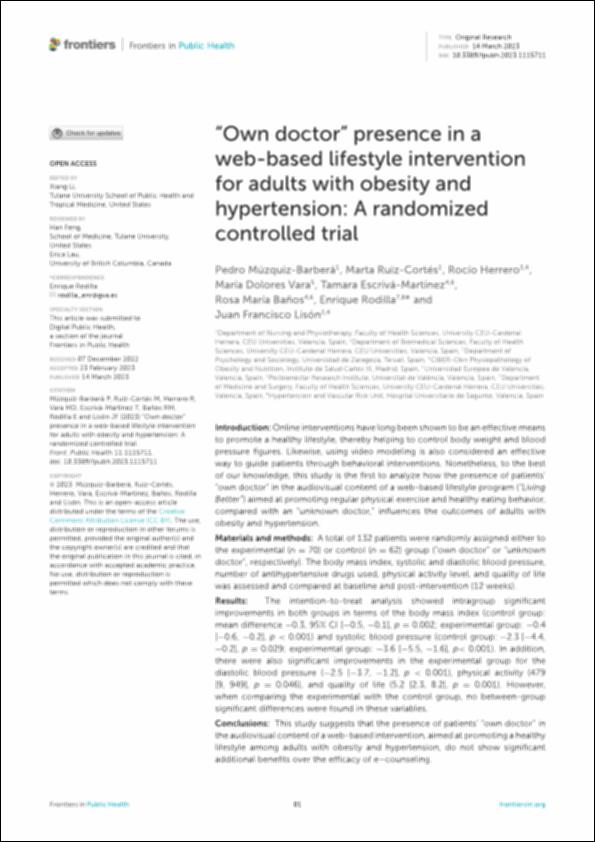Por favor, use este identificador para citar o enlazar este ítem:
http://hdl.handle.net/10637/14776“Own doctor” presence in a web-based lifestyle intervention for adults with obesity and hypertension: a randomized controlled trial
| Título : | “Own doctor” presence in a web-based lifestyle intervention for adults with obesity and hypertension: a randomized controlled trial |
| Autor : | Múzquiz Barberá, Pedro Ruiz Cortés, Marta Herrero, Rocío Vara Villodre, María Dolores Escrivá Martínez, Tamara Baños Rivera, Rosa María Rodilla Sala, Enrique Lisón Párraga, Juan Francisco |
| Materias: | Dietética; Dietetics; Nutrición; Nutrition; Obesidad; Obesity; Educación física; Physical education; Estilo de vida; Life styles |
| Editorial : | Frontiers Media |
| Citación : | Múzquiz-Barberá, P., Ruiz-Cortés, M., Herrero, R., Vara, M. D., Escrivá-Martínez, T., Baños, R. M., Rodilla, E. & Lisón, J. F. (2023). "Own doctor" presence in a web-based lifestyle intervention for adults with obesity and hypertension: a randomized controlled trial. Frontiers in Public Health, vol. 11, art. 1115711 (14 mar.). DOI: https://doi.org/10.3389/fpubh.2023.1115711 |
| Resumen : | Introduction:Online interventions have long been shown to be an eectivemeans to promote a healthy lifestyle, thereby helping to control body weight and blood pressure figures. Likewise, using video modeling is also considered an eective way to guide patients through behavioral interventions. Nonetheless, to the best of our knowledge, this study is the first to analyze how the presence of patients’ “own doctor” in the audiovisual content of a web-based lifestyle program (“Living Better”) aimed at promoting regular physical exercise and healthy eating behavior, compared with an “unknown doctor,” influences the outcomes of adults with obesity and hypertension. Materials and methods: A total of 132 patients were randomly assigned either to the experimental (n = 70) or control (n = 62) group (“own doctor” or “unknown doctor”, respectively). The body mass index, systolic and diastolic blood pressure, number of antihypertensive drugs used, physical activity level, and quality of life was assessed and compared at baseline and post-intervention (12 weeks). Results: The intention-to-treat analysis showed intragroup significant improvements in both groups in terms of the body mass index (control group: mean dierence −0.3, 95% CI [−0.5, −0.1], p = 0.002; experimental group: −0.4 [−0.6, −0.2], p < 0.001) and systolic blood pressure (control group: −2.3 [−4.4, −0.2], p = 0.029; experimental group: −3.6 [−5.5, −1.6], p< 0.001). In addition, there were also significant improvements in the experimental group for the diastolic blood pressure (−2.5 [−3.7, −1.2], p < 0.001), physical activity (479 [9, 949], p = 0.046), and quality of life (5.2 [2.3, 8.2], p = 0.001). However, when comparing the experimental with the control group, no between-group significant dierences were found in these variables. Conclusions: This study suggests that the presence of patients’ “own doctor” in the audiovisual content of a web-based intervention, aimed at promoting a healthy lifestyle among adults with obesity and hypertension, do not show significant additional benefits over the e cacy of e–counseling. |
| URI : | http://hdl.handle.net/10637/14776 |
| Derechos: | OpenAccess |
| ISSN : | 2296-2565 (Electrónico) |
| Fecha de publicación : | 14-mar-2023 |
| Centro : | Universidad Cardenal Herrera-CEU |
| Aparece en las colecciones: | Dpto. Ciencias Biomédicas |
Los ítems de DSpace están protegidos por copyright, con todos los derechos reservados, a menos que se indique lo contrario.


